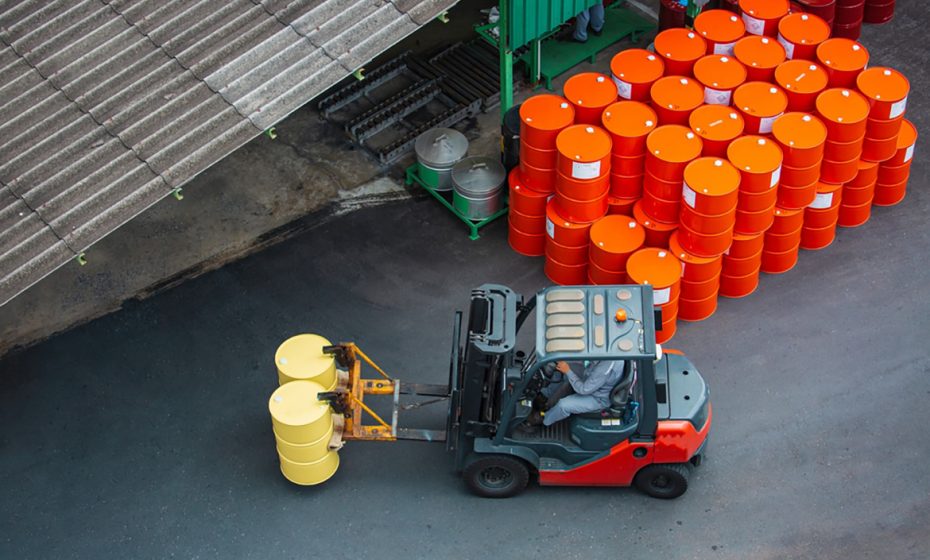Can you ship liquids from within the U.S., either domestically or internationally? The shorter answer is yes; the longer answer is it depends on what type of liquid it is and where you’re shipping it. You also need to make sure you use the right drum barrel or container, depending on the item being shipped.
What Liquids Can You Ship?
In general, you can ship liquids that won’t cause injury. While different carriers have different restrictions regarding which liquids they will and won’t ship, all carriers will only ship liquids that are:
- Non-flammable
- Non-corrosive
- Non-explosive
- Non-odoriferous
- Non-hazardous/non-poisoning

Source: noomcpk/shutterstock.com
That means, domestically, you can always ship juices, beverages, oils, perfumes, soups and soaps, and other similar items. You can also ship certain items in limited quantities, such as qualifying paints and spray paints, rubbing alcohol, witch hazel, propane (in pressurized containers), and acetone.
There are certain exceptions to these rules, such as for liquids in aerosol cans, which you can ship by surface mail but not by airmail transport.
Shipping Liquids Internationally
If you want to ship liquids internationally, the number of prohibited liquids increases including gasoline, nail polish, and perfumes containing alcohol. You can, however, ship liquids like non-hazardous pastes and creams, non-alcoholic beverages, and, of course, water both domestically and internationally.
Depending on the destination country, you may also need to procure a license or permit to ship certain liquids. As for the question: “How can you ship liquids?” here’s how the food industry does it, step by step.
Step 1: Seal Your Liquid
Before you package the liquid for shipment, you must first make sure the liquid is securely sealed within its own container. This may include wrapping additional plastic around any caps or openings to prevent leaks.
If you’re shipping a large volume of liquid without its own container that you plan to pour directly into a sealed, secure shipping container, such as drum barrels, then you can skip this step and move on to the next one.
Step 2: Package the Liquid Properly
First, you need to properly package the liquid you want to ship so it doesn’t break, get punctured or leak. That means you must seal the liquid within a waterproof container.
If it’s a small amount of liquid you’re shipping, place it inside a waterproof bag or other permitted container. Then, you will pack it inside a cardboard shipping box. If you’re shipping large volumes of water, then the waterproof container is the shipping container and there is no need for an additional box.
See Our IBC Totes for Your Shipping Needs
One of the most common and effective containers for shipping everything from industrial liquids to water is an IBC tote that’s plastic and surrounded by a steel cage to protect it from physical damage.
You may also want to consider pallet containers for bulk storage. These can be in a collapsible or non-collapsible material to protect the items you want to ship.

Source: General photographer/shutterstock.com
Perishable vs. Non-Perishable Liquids
Perishable liquids must be properly protected, while they and other liquids may also need to be temperature-regulated. Depending on the liquid, you may need to protect it from degrading or preserve its freshness. IBC totes are food-grade, though they don’t necessarily need to be used for those purposes.
Pack perishables inside a bottle carrier or Styrofoam cooler before setting them inside a cardboard shipping box.
For non-perishable liquids, if you choose a glass bottle or container, the USPS suggests first placing the liquid inside a sealed and waterproof inner container. Place that container inside the glass container with ample cushioning material between them.
If you’re shipping paints, make sure they’re not stored inside paint cans that have friction-top enclosures (aka push-down tops) unless you place them within a more solid and secure outer packaging.
For large volumes of non-perishable liquids, drum barrels are a convenient option as they’re stackable and you can ship them internationally.
Step 3: Label All Packages
Before bringing your package to a shipper or scheduling pickup of your package, be sure to label it as containing liquids. One common and easy way to do this is to write “LIQUIDS” or “LIQUID” with a marker clearly on the outside of the package. If you’re shipping more than one package, make sure you individually label each package this way.
Step 4: Choose Your Carrier
You have your choice of several carriers to use to ship your liquids, the most common being the U.S. Post Office (USPS,) United Parcel Service (UPS), and Federal Express (FedEx.) Each one has its own set of rules and rates. It’s recommended you call any carrier you’re considering using to find out those that apply to your shipment.

Source: FOTOGRIN/shutterstock.com
Step 5: Ship Your Package
Once you’ve chosen your carrier, either bring your package(s) to their nearest location or contact them to schedule a pickup of your packages. At that time, you will pay for the shipment, and you can choose any additional services you might like, such as delivery confirmation or certified delivery.
Conclusion
You can ship liquids within the U.S. and outside of it with certain restrictions and requirements. For the shipping containers that best suit your requirements from drum barrels to IBC containers, check out the new and resale liquid containers at Container Exchanger.
